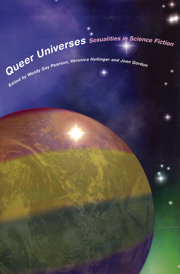Book contents
- Frontmatter
- Contents
- Acknowledgements
- Notes on Contributors
- Introduction: Queer Universes
- Part I Queering the Scene
- Part II Un/Doing History
- Part III Disordering Desires
- ‘Something Like a Fiction’: Speculative Intersections of Sexuality and Technology
- ‘And How Many Souls Do You Have?’: Technologies of Perverse Desire and Queer Sex in Science Fiction Erotica
- BDSMSF(QF): Sadomasochistic Readings of Québécois Women's Science Fiction
- Part IV Embodying New Worlds
- Works Cited
- Index
‘Something Like a Fiction’: Speculative Intersections of Sexuality and Technology
from Part III - Disordering Desires
- Frontmatter
- Contents
- Acknowledgements
- Notes on Contributors
- Introduction: Queer Universes
- Part I Queering the Scene
- Part II Un/Doing History
- Part III Disordering Desires
- ‘Something Like a Fiction’: Speculative Intersections of Sexuality and Technology
- ‘And How Many Souls Do You Have?’: Technologies of Perverse Desire and Queer Sex in Science Fiction Erotica
- BDSMSF(QF): Sadomasochistic Readings of Québécois Women's Science Fiction
- Part IV Embodying New Worlds
- Works Cited
- Index
Summary
If gender is the social construction of sex, and if there is no access to this ‘sex’ except by means of its construction, then it appears not only that sex is absorbed by gender, but that ‘sex’ becomes something like a fiction, perhaps a fantasy…
— Judith Butler, Bodies That Matter 5Alas! those who were shocked at my making love that way to a man are now shocked at my making love to a machine; you can't win.
— Joanna Russ, The Female Man 200In his recent cultural history of the genre, Roger Luckhurst astutely describes the project of science fiction as ‘speculation on the diverse results of the conjuncture of technology and subjectivity’ (222). In the past two decades or so, Anglo-American sf has undertaken this kind of speculative project in the most literal of ways – the concretization of metaphor being a particularly favoured sf strategy – whether exploring the impact of technoculture on the human subject as such in its many cyborg stories or attempting to trace the ontological features of our artificial progeny in stories about robots and other forms of artificial intelligences. Since the mid-1980s in particular, especially in response to the cyberpunk phenomenon, sf has almost obsessively (re)imagined the post-human subject at a variety of ‘conjunctures’ with the technological.
- Type
- Chapter
- Information
- Queer UniversesSexualities in Science Fiction, pp. 140 - 160Publisher: Liverpool University PressPrint publication year: 2010
- 1
- Cited by

